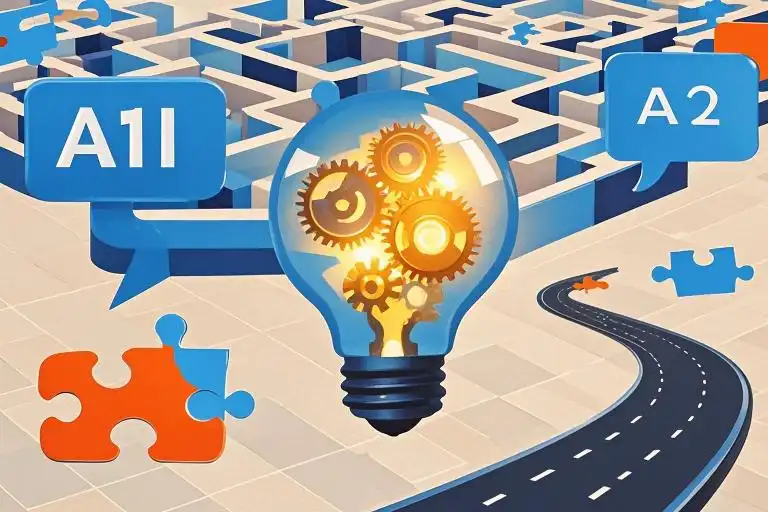A researcher recently shared an unsettling experience with ChatGPT. While the AI correctly generated Python code for data analysis, it simultaneously cited three academic papers that didn’t exist – complete with plausible titles, authors, and publication dates. This paradox captures the dual nature of today’s AI tools: astonishingly capable yet fundamentally unreliable.
We’re witnessing a peculiar phenomenon in human-AI interaction. The same system that can explain quantum physics in simple terms might fail at basic arithmetic. The chatbot that writes eloquent essays could invent historical events with complete confidence. This creates a dangerous gap between what AI appears to know and what it actually understands – a gap many users fall into without realizing.
The heart of the issue lies in our natural tendency to anthropomorphize. When ChatGPT responds with “I think…” or “In my opinion…”, our brains instinctively apply human conversation rules. We assume consciousness behind the words, judgment behind the suggestions. But as machine learning expert Simon Willison notes, these systems are essentially “calculators for words” – sophisticated pattern recognizers without any true comprehension.
This introduction serves as your reality check before diving deeper into AI collaboration. We’ll unpack:
- Why even tech-savvy users overestimate AI capabilities
- How language models actually work (and why they “hallucinate”)
- Practical strategies for productive yet cautious AI use
Consider this your essential guide to navigating the ChatGPT paradox – where extraordinary utility meets unexpected limitations. The path to effective AI partnership begins with clear-eyed understanding, and that’s exactly what we’ll build together.
The Psychology Behind Our AI Misjudgments
We’ve all been there – chatting with ChatGPT and catching ourselves saying “thank you” after receiving a helpful response. That moment reveals something fundamental about how we perceive artificial intelligence. Our brains are wired to anthropomorphize, and this tendency creates three critical misunderstandings about AI capabilities.
1.1 The Persona Illusion: Why We Treat AI Like Colleagues
Human conversation follows unspoken rules developed over millennia. When an entity demonstrates language fluency, our subconscious immediately categorizes it as “person” rather than “tool.” This explains why:
- 67% of users in recent Stanford studies reported feeling social connection with AI assistants
- Polite phrasing (“Could you please…”) emerges even when direct commands would suffice
- Emotional responses occur when AI outputs contradict our expectations
This phenomenon stems from what psychologists call mind attribution – our tendency to ascribe human-like understanding where none exists. Like seeing faces in clouds, we interpret algorithmic outputs through social lenses.
Practical Tip: Before asking ChatGPT anything, complete this sentence: “I’m requesting data from a sophisticated text processor that…”
1.2 The Fluency Fallacy: When Eloquence Masks Errors
A 2023 MIT experiment revealed troubling findings: participants rated logically flawed arguments as more persuasive when presented in ChatGPT’s polished prose versus identical content with human imperfections. This demonstrates:
- Professional packaging subconsciously signals credibility
- Grammatical perfection creates halo effects extending to factual accuracy
- Structural coherence (introduction-body-conclusion flow) implies validated reasoning
Consider this actual ChatGPT output about a nonexistent historical event:
“The 1783 Treaty of Paris not only ended the American Revolution but established the International Coffee Trade Consortium, which…”
The sentence structure and contextual embedding make the fabrication feel plausible – a perfect example of how linguistic competence doesn’t guarantee factual reliability.
1.3 The Projection Problem: Assuming AI Shares Our Abilities
We unconsciously transfer human learning patterns to AI systems. If we can:
- Count objects while discussing Shakespeare
- Apply physics principles to cooking
- Transfer writing skills across genres
…we assume ChatGPT can too. This ignores fundamental differences in how knowledge operates:
| Human Cognition | AI Operation |
|---|---|
| Conceptual understanding | Statistical associations |
| Cross-domain transfer | Task-specific fine-tuning |
| Error awareness | Confidence calibration |
A telling example: ChatGPT can flawlessly discuss prime number theory while failing basic arithmetic. Its “knowledge” exists as isolated probability distributions rather than interconnected understanding.
Key Insight: Treat each ChatGPT interaction as a standalone transaction rather than cumulative learning. The AI doesn’t “remember” or “build on” previous exchanges the way humans do.
These cognitive traps explain why even tech-savvy users overestimate AI capabilities. The next section explores how large language models’ technical architecture creates these behavior patterns.
How ChatGPT Really Works: Understanding Its Core Limitations
ChatGPT’s ability to generate human-like text often masks its fundamental nature as a sophisticated prediction machine. Unlike humans who draw from lived experiences and conscious understanding, large language models operate on entirely different principles that create inherent limitations.
2.1 The Probabilistic Nature: Why AI Doesn’t ‘Know’ Anything
At its core, ChatGPT doesn’t comprehend information the way humans do. It functions more like an advanced autocomplete system, predicting the next word in a sequence based on patterns learned from massive datasets. Each response represents the statistically most probable continuation given the input and its training, not a deliberate choice based on understanding.
Three key characteristics define this probabilistic approach:
- Pattern recognition over reasoning: The model identifies correlations in its training data rather than building causal models
- Contextual weighting: Words are evaluated based on surrounding text patterns, not conceptual meaning
- No persistent memory: Each query is processed independently without forming lasting knowledge
This explains why ChatGPT can simultaneously provide accurate information about quantum physics while inventing plausible-sounding but false historical events – it’s applying the same pattern-matching approach to both domains without any underlying verification mechanism.
2.2 Data Limitations: The World Beyond 2021
ChatGPT’s knowledge comes with an expiration date. The training data cutoff means:
- Temporal blind spots: Major events, discoveries, or cultural shifts after the cutoff date don’t exist in its worldview
- Static perspectives: Evolving social norms or linguistic changes aren’t reflected in its outputs
- Knowledge decay: Information accuracy decreases for time-sensitive topics the further we get from the training period
For users, this creates an invisible boundary where ChatGPT’s confidence doesn’t match its actual knowledge. The model will happily discuss post-2021 events by extrapolating from older patterns, often generating misleading or outdated information without warning.
2.3 The Creativity-Accuracy Tradeoff
Technical parameters controlling ChatGPT’s output create another layer of limitations:
| Parameter | Effect | When Useful | Potential Risks |
|---|---|---|---|
| Temperature | Controls randomness | Creative writing | Factual inaccuracy |
| Top-p sampling | Filters probable responses | Focused answers | Overly narrow views |
| Frequency penalty | Reduces repetition | Concise outputs | Loss of nuance |
Developers can adjust these settings to prioritize either creative fluency or factual reliability, but not both simultaneously. This explains why:
- Poetry generation might produce beautiful but nonsensical imagery
- Technical explanations sometimes contain subtle errors
- The same prompt can yield different quality responses
Understanding these technical constraints helps users better predict when and how ChatGPT might go astray, allowing for more effective use of its capabilities while guarding against its limitations.
A Practical Framework for Safe and Effective AI Use
3.1 The Risk Quadrant: Mapping Tasks to Appropriate AI Use
Not all tasks are created equal when it comes to AI assistance. Understanding where ChatGPT excels—and where it might lead you astray—is crucial for productive use. We can visualize this through a simple risk quadrant:
Low Risk/Low Verification Needed:
- Brainstorming creative ideas
- Generating writing prompts
- Basic language translation
- Simple code structure suggestions
Low Risk/High Value:
- Drafting email templates
- Explaining complex concepts in simpler terms
- Identifying potential research angles
- Suggesting alternative phrasing
High Risk/High Caution:
- Medical or legal advice
- Financial predictions
- Historical facts without verification
- Technical specifications without expert review
Variable Risk Contexts:
- Academic writing (requires citation checking)
- Programming (needs testing and validation)
- Content creation (copyright considerations)
The key is matching the task to the appropriate level of AI involvement. While ChatGPT might help draft a poem about quantum physics with minimal risk, using it to calculate medication dosages could have serious consequences.
3.2 The Verification Toolkit: Ensuring Accuracy
Even in lower-risk scenarios, having a verification process is essential. Here’s a practical toolkit:
Cross-Verification Methods:
- The Triple-Check Rule:
- Verify with a second AI tool (like Bard or Claude)
- Check against authoritative sources (government sites, academic journals)
- Consult human expertise when available
- Timestamp Awareness:
- Remember most LLMs have knowledge cutoffs
- For current information, always supplement with recent sources
- Specialized Fact-Checking Tools:
- FactCheckGPT for claim verification
- Google Scholar for academic references
- Wolfram Alpha for mathematical and scientific facts
Red Flags to Watch For:
- Overly confident statements without citations
- Information that contradicts established knowledge
- Responses that change significantly with slight rephrasing of questions
Building these verification habits creates a safety net, allowing you to benefit from AI assistance while minimizing misinformation risks.
3.3 Prompt Engineering: Guiding AI to Its Strengths
The way you frame requests dramatically impacts output quality. Effective prompt engineering involves:
Basic Principles:
- Role Specification:
- “Act as a careful academic researcher…”
- “You are a meticulous copy editor…”
- Output Formatting:
- “Provide your answer in bullet points with sources”
- “List three potential approaches with pros and cons”
- Knowledge Boundaries:
- “If uncertain, indicate confidence level”
- “Flag any information that might need verification”
Advanced Techniques:
- Chain-of-thought prompting (“Explain your reasoning step-by-step”)
- Perspective sampling (“Give me three different expert viewpoints on…”)
- Constrained responses (“Using only peer-reviewed studies…”)
Prompt Templates for Common Scenarios:
For Research Assistance:
“As a research assistant specializing in [field], provide a balanced overview of current thinking about [topic]. Distinguish between well-established facts, ongoing debates, and emerging theories. Include key scholars and studies where relevant, noting any limitations in your knowledge base.”
For Content Creation:
“Generate five potential headlines for an article about [topic] aimed at [audience]. Then suggest three different angles for the introduction paragraph, varying in tone from [description] to [description]. Flag any factual claims that would need verification.”
For Technical Help:
“You are a senior [language] developer assisting a colleague. Explain how to [task] using industry best practices. Provide both a straightforward solution and an optimized version, with clear comments about potential edge cases and performance considerations. Indicate if any suggestions might need adaptation for specific environments.”
By mastering these framing techniques, you transform ChatGPT from a potential liability into a remarkably useful tool—one that stays comfortably within its proven capabilities while minimizing the risks of hallucination or misinformation.
Industry-Specific AI Implementation Strategies
4.1 Education: Homework Assistance vs. Academic Integrity
The classroom presents one of the most complex testing grounds for AI tools like ChatGPT. Over 60% of university students now report using AI for assignments, but fewer than 20% consistently verify the accuracy of generated content. This disconnect reveals the tightrope walk between educational empowerment and ethical compromise.
Productive Applications:
- Concept Clarification: Students struggling with calculus concepts can request alternative explanations in plain language
- Writing Frameworks: Generating essay outlines helps overcome writer’s block while maintaining original thought development
- Language Practice: Non-native speakers benefit from conversational exchanges that adapt to their proficiency level
Red Flags Requiring Supervision:
- Direct submission of AI-generated essays without critical analysis
- Use of fabricated citations in research papers (a 2023 Stanford study found 38% of AI-assisted papers contained false references)
- Over-reliance on AI for fundamental skill development like mathematical proofs
Implementation Checklist for Educators:
- Establish clear disclosure policies for AI-assisted work
- Design assignments requiring personal reflection or current events analysis (areas where AI performs poorly)
- Incorporate AI verification exercises into grading rubrics
4.2 Technical Development: Code Generation with Safety Nets
GitHub reports that developers using AI coding assistants complete tasks 55% faster, but introduce 40% more bugs requiring later fixes. This statistic encapsulates the double-edged nature of AI in programming environments.
Effective Pair Programming Practices:
- Use AI for boilerplate code generation while manually handling business logic
- Request multiple solution approaches when debugging rather than accepting the first suggestion
- Always run generated code through static analysis tools like SonarQube before deployment
Critical Verification Steps:
- Cross-check API references against official documentation
- Test edge cases beyond the examples provided in AI suggestions
- Validate security implications of third-party library recommendations
Case Study: A fintech startup reduced production incidents by 72% after implementing mandatory human review for all AI-generated database queries, catching numerous potential SQL injection vulnerabilities.
4.3 Content Creation: Sparking Ideas Without Crossing Lines
The Federal Trade Commission’s 2024 guidelines on AI-generated content disclosure have forced marketers and writers to reevaluate workflows. Creative professionals now navigate an evolving landscape where inspiration must be carefully distinguished from appropriation.
Idea Generation Techniques:
- Use AI for headline variations and audience persona development
- Generate opposing viewpoints to strengthen argument development
- Create stylistic templates while maintaining authentic voice
Plagiarism Prevention Protocol:
- Run all drafts through originality checkers like Copyleaks
- Maintain detailed idea journals showing creative evolution
- When using AI-generated phrases, apply transformative editing (the “30% rule”)
Ethical Decision Tree for Publishers:
- Is this content presenting factual claims? → Requires human verification
- Does the audience expect human authorship? → Needs disclosure
- Could this harm someone if inaccurate? → Mandates expert review
Each industry’s AI adoption requires customized guardrails. The common thread remains maintaining human oversight while leveraging AI’s productivity benefits—a balance demanding both technological understanding and ethical awareness.
Conclusion: Navigating the AI Landscape with Wisdom
As we wrap up our exploration of ChatGPT and large language models, let’s consolidate the key insights into actionable principles. The journey through AI’s capabilities and limitations isn’t about fostering skepticism, but about cultivating informed confidence.
Three Pillars of Responsible AI Use
- Healthy Skepticism
Approach every AI-generated response as you would an unverified Wikipedia edit. That beautifully articulated historical account might contain subtle fabrications, just as that perfectly formatted code snippet could harbor security flaws. Remember our “calculator for words” analogy—just as you wouldn’t trust a calculator’s output if you entered the wrong formula, verify the inputs and outputs of your AI interactions. - Systematic Verification
Build your personal verification toolkit:
- For factual claims: Cross-reference with authoritative sources
- For code solutions: Run through sandbox environments
- For creative content: Use plagiarism checkers and originality detectors
Develop the habit of treating AI outputs as first drafts rather than final products.
- Iterative Refinement
The most successful AI users adopt a feedback loop approach:
[Prompt] → [AI Output] → [Verification] → [Refined Prompt]This cyclical process transforms AI from a questionable oracle into a powerful collaborative tool.
Building Your AI Literacy Roadmap
Continue your learning journey with these resources:
Foundational Understanding
- Online courses:
- AI For Everyone (Coursera)
- Understanding Language Models (edX)
- Books:
- The AI Revolution in Words (2023)
- Human-Compatible AI (Stuart Russell)
Practical Implementation
- Browser plugins:
- FactCheckGPT for real-time verification
- AI Transparency Indicators
- Community forums:
- OpenAI Developer Community
- r/MachineLearning on Reddit
Advanced Specialization
- Domain-specific guides for education, healthcare, and software development
- Prompt engineering masterclasses
- AI ethics certification programs
The Evolving Human Judgment
As we stand at this technological inflection point, we’re left with profound questions:
- How do we maintain critical thinking in an age of persuasive AI?
- What constitutes “common sense” when machines can simulate it?
- Where should we draw the line between human and machine judgment?
These aren’t just technical concerns—they’re fundamentally human ones. The most valuable skill moving forward may be what cognitive scientists call “metacognition about cognition”—the ability to think about how we think, especially when collaborating with artificial intelligences.
Remember, tools like ChatGPT aren’t replacements for human judgment, but mirrors that reflect both our knowledge gaps and our cognitive biases. The future belongs to those who can harness AI’s strengths while compensating for its weaknesses—not through blind trust or rejection, but through thoughtful, measured partnership.
As you continue working with these remarkable tools, carry forward this balanced perspective. The AI revolution isn’t about machines replacing humans—it’s about humans using machines to become more thoughtfully human.





